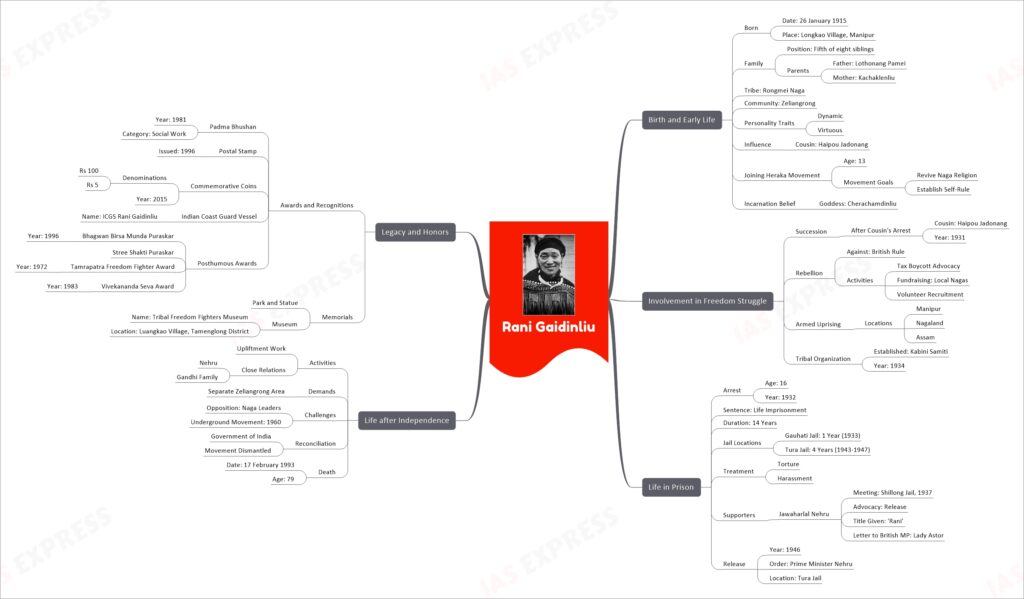Rani Gaidinliu – A Naga Freedom Fighter
Rani Gaidinliu (26 January 1915 – 17 February 1993) was a Naga spiritual and political leader who, at the age of 13, joined the Heraka religious movement and later led a rebellion against British colonial rule in India. Imprisoned at 16, she spent 14 years in jail before being released in 1947. Post-independence, she continued to advocate for her people’s rights and cultural identity.
This topic of “Rani Gaidinliu – A Naga Freedom Fighter” is important from the perspective of the UPSC IAS Examination, which falls under General Studies Portion.
Early Life of Rani Gaidinliu
- Born on January 26, 1915, in Longkao (Nungao) village of Manipur.
- Fifth child among six sisters and one younger brother.
- Parents: Lothonang Pamei (father) and Kachaklenliu (mother).
- Belonged to the Rongmei Naga tribe, part of the Zeliangrong community.
- Known for her dynamic and virtuous personality from childhood.
- At age 13, influenced by her cousin Haipou Jadonang, she joined the Heraka religious movement.
- The Heraka movement aimed to revive Naga tribal religion and establish self-rule.
- Gaidinliu was considered an incarnation of the Goddess Cherachamdinliu within the Heraka faith.
- Became a political leader, leading a rebellion against British colonial rule in India.
Involvement in the Freedom Struggle
- After the arrest and execution of her cousin Haipou Jadonang by the British in 1931, Gaidinliu emerged as his spiritual and political successor.
- She openly rebelled against British rule, urging the Zeliangrong people not to pay taxes.
- Gaidinliu received donations from local Nagas, many of whom also joined her as volunteers.
- She led an armed uprising against the British in Manipur, Nagaland, and Assam.
- She established a tribal organization, Kabini Samiti, in 1934.
Life in Prison
- Arrested in 1932 at the age of 16, Gaidinliu was sentenced to life imprisonment by the British.
- She spent her youthful life in different jails of British India for 14 years.
- Her prison life included 1 year in Gauhati jail in 1933, and 4 years in Tura jail from 1943 to 1947.
- During her imprisonment, she was reportedly tortured and harassed by the British rulers.
- In 1937, Jawaharlal Nehru met her in Shillong Jail, promising to pursue her release.
- Nehru described Gaidinliu as a “daughter of the hills” and gave her the title ‘Rani’ or Queen.
- Nehru also wrote to the British MP Lady Astor, advocating for Gaidinliu’s release.
- Despite the harsh conditions, Gaidinliu’s spirit remained unbroken, as she continued to dream of freedom for her people.
- After the Interim Government of India was set up in 1946, Gaidinliu was released on Prime Minister Nehru’s orders from Tura jail.
Life after Independence
- After her release from prison in 1946, Gaidinliu continued to work for the upliftment of her people.
- She initially stayed at Vimrap village of Tuensang with her younger brother Marang till 1952.
- In 1952, she was finally allowed to move back to her native village of Longkao.
- Gaidinliu remained close to Nehru and the Gandhi family.
- She demanded a separate Zeliangrong area within the Union of India.
- Facing opposition from other Naga leaders for her demand, she was forced to go underground in 1960.
- She later reached an understanding with the Government of India and dismantled the underground movement.
- She passed away on 17 February 1993, at the age of 79.
Legacy and Honors
- The Government awarded Rani Gaidinliu the prestigious Padma Bhushan award in 1981 for her social work.
- The Government of India issued a postal stamp in her honor in 1996.
- In 2015, the Indian government issued commemorative coins of Rs 100 and a circulation coin of Rs 5 in her honor.
- The Indian Coast Guard commissioned a Fast Patrol Vessel named “ICGS Rani Gaidinliu.”
- She was posthumously awarded the Bhagwan Birsa Munda Puraskar in 1996.
- The Government of India instituted an award called Stree Shakti Puraskar in honor of five eminent women, of whom Rani Gaidinliu was one.
- She was conferred with the ‘Tamrapatra Freedom Fighter Award’ in 1972 and Vivekananda Seva Award in 1983.
- A park along with a statue has been developed by the state government to honor the late freedom fighter.
- The Tribal Freedom Fighters museum was named after her and is set up in her birthplace, Luangkao Village in Tamenglong district.
Rani Gaidinliu, a Naga spiritual and political leader, is remembered for her significant contributions to India’s freedom struggle and her relentless advocacy for the rights and cultural identity of her people. Despite enduring years of imprisonment and hardship, her spirit remained unbroken. Her legacy continues to inspire, and she has been honored posthumously with numerous awards and recognitions, including a postal stamp, commemorative coins, and a museum named after her.


